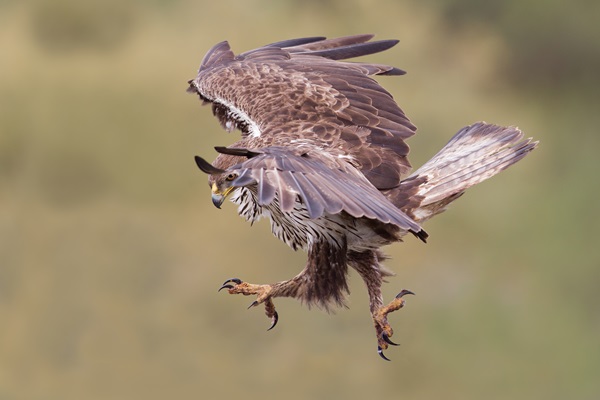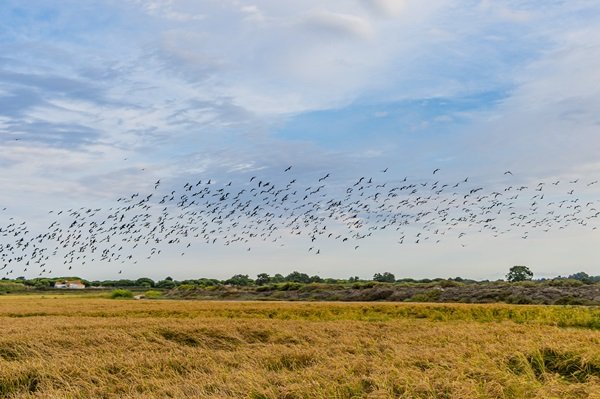The Alentejo sky is a symphony of thousands of birds. Here you can find rare species such as the Iberian imperial eagle, the great bustard, the kestrel or the roller at the Sado Estuary Nature Reserve. Along the Atlantic coast’s Sudoeste Alentejano e Costa Vicentina Nature Park, you can find rare species such as the little bustard, stone-curlew, Thekla's lark and Richard's Pipit. Also on the coast, Cape Sines and Cape Sardão are great places to observe seabirds, such as sandwich terns and shearwaters. And, with birds come birders from distant lands, making Alentejo an incredible location for birding. In fact, Eu Ouvi Um Passarinho (I heard a little bird) is a traditional Alentejo song.
Part of the joy is that the Alentejo’s sky is a natural wonder. By day the blue sky is home to species including Montagu's harrier, Bonelli's eagle, scops owl, purple swamp hen, black-winged kite, and azure-winged magpie along with many others. With hundreds of protected species found in their natural habitats, the Alentejo is a birders' wonderland, so grab your binoculars and camera and follow their song.
Much of the Alentejo coast, especially the southern stretch, is undeveloped, wild, and protected forever. The pounding surf and exhilarating spray are the key, with the waves at their best from fall through spring.
The Alentejo's parks and nature reserves are the perfect way to discover the birds of the Alentejo, with endless montado cork forests, protected by law — preserving nature and traditional ways of living in a sustainable way.

Where to Bird Watch
The Sado Estuary Nature Reserve, which you can explore on foot, by bike, in a canoe or even in a traditional wooden boat called Galeões do Sal. Here, where the Sado River meets the Atlantic, you can explore salt marshes, rare plants, and coastal dunes. More than 250 bird species call these waters home, as do the local dolphins that thrive in these calm waters. You can spot the local flamingos that live in this nature reserve, too. Take a boat trip to see the many species that inhabit the estuary, and enjoy the calm.
Head south into the Sudoeste Alentejano e Costa Vicentina Nature Park. With unique geology and about 30 distinct habitats, it is home to more than 100 plant species that can only be found here. Many bird species make their nests in the tall cliffs, including the only storks in the world that live in cliffs around Cabo Sardão. Other marine birds like the northern gannet, the Cory’s shearwater, or even the balearic shearwater can be seen.
The Vale do Guadiana Nature Park is inland from the Atlantic, past Castro Verde. A World Biosphere Reserve where the plains dominated by crops, fallows, and natural grasslands are occasionally interrupted by vineyards, olive groves and oak forests. In the Vale do Guadiana Nature Park, discover the Pulo do Lobo gorge, a 112-foot waterfall in a narrow gorge of the River Guadiana. You can also see deer, golden eagles, black vultures, bustards or even a rare Iberian lynx.
In the Serra de São Mamede Natural Park, encounter a hillier Alentejo, dominated by high mountains instead of rolling plains. The mountain range functions as a barrier for condensation, creating a microclimate with precipitation and humidity levels higher than the surrounding areas. The park offers five pedestrian trails, through which it is possible to appreciate the varied vegetation and observe rare birds of prey such as the vulture, kite or Bonelli eagle — the emblem of the park. With a bit of luck, you might see a wild boar or deer returning to the Serra de São Mamede following an effort to reconstitute their habitats.
Lagoas de Santo André e da Sancha Nature Reserve is a coastal reserve that is home to many species of seasonal birds, ponds and endless views over blue waters and golden sands. Set by the Atlantic, the waters of the Lagoas de Santo André and Sancha Nature Reserve shelter species such as eels and the pardelha loach, one of the rarest fish in Portuguese waters. And the dunes welcome thousands of migratory birds, especially the red-crested pochard flamingo and little tern. Some of the species that you can see at Lagoa de Santo André include the red-crested pochard, tufted duck, black-winged kite, Eurasian hoopoe, and Iberian magpie — to name a few.



